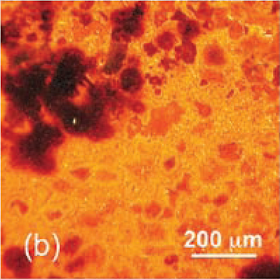
When I was a PhD student, I published a short paper in the Proceedings of the VIIth International Kimberlite Conference on luminescence from radiation-induced crystallographic defects in carbonado, a type of polycrystalline diamond. Being a proceedings paper, it was short format- 4 pages, and 6 figures. This work found its way into my Thesis, of course. But since the structural and stylistic conventions of a PhD thesis differ from that of a conference proceedings, that version was 49 pages and 34 figures. After graduating, I tried to publish a condensed version of the full work, but I couldn’t get it accepted anywhere- the conclusions were no different than the short version that came out in ’99, so it was considered uninteresting, old news, and beating a dead horse. I gave up submitting it sometime in 2003 or so.
Fast forward to last year. Yokochi et al. (2008) publish a lovely paper of carbonado spectrometry and microtexture. Their photomicrographs are probably the best published to date. They see the same spectrographic peaks and textural features that have been known since Fettke & Sturges (1933). And with the addition of some nice stable isotope and argon work, they find a novel way to put it all together.
 Figure 1: Yokochi et al.'s figure 1b, showing euhedral phenocrysts in a bright matrix. I reckon the CL-dark areas in the upper left of the figure are probably from epigenetic radiation damage. Evidently he prefers another explanation.
Figure 1: Yokochi et al.'s figure 1b, showing euhedral phenocrysts in a bright matrix. I reckon the CL-dark areas in the upper left of the figure are probably from epigenetic radiation damage. Evidently he prefers another explanation.In the process of interpreting their fabulous images, they say:
These circular textures are analogous to CL images of carbonado from Central Africa in previous studies (Magee & Taylor 1999, Kagi et al. 2007). Although these authors interpreted them as a result of radiation damage, our cathodoluminescence images show no link between the circular texture and the pores in which the radioactive elements might have been resided. Moreover, the size of this circular texture is occasionally larger than the range of a-particle influence (20 µm). An alternative hypothesis for this particular sample may be that this circular texture had first formed as phenocrysts at earlier stage, and the rounded shape and vague boundaries imply either a partial dissolution of the phenocrysts prior to the formation of the flow structure or an annealing that has erased the sharp boundary after a discontinuous growth.
Now, I don’t think their interpretation is correct. In fact, I have a highly detailed case to support our original interpretation- which is that grain-boundary-crossing CL quench features are epigenetic in origin. But it has been sitting in the back of my garage since we bought the house because nobody has ever doubted the short&sweet version before. Hopefully, the emergence of an alternative hypothesis will make the longer argument relevant.
So, if I’m not blogging here, it means that I’m trying to track down co-authors from a dozen years ago in order to get this paper submitted. Or it means my daughter’s sick. Or the garden needs attention. Or I’m wasting time on facebook instead of wasting time blogging.
Just like carbonado cathodoluminescence features, there are not several competing hypotheses for light blogging here at the lounge.
Refs:
Fettke, C.R., and Sturges, F.C., 1933, Structure of carbonado or black diamond: American Mineralogist, v. 18, p. 172-174.
Kagi, H., Sato, S., Akagi, T., and Kanda, H., 2007, Generation history of carbonado inferred from photoluminescence spectra, cathodoluminescence imaging, and carbon-isotopic composition. American Mineralogist, Volume 92, pages 217-224.
Magee, C.W. & Taylor , W.R. (1999): Constraints from luminescence on the history and origin of carbonado. Int. Kimberlite Conf., 529-532.
Magee, C. W. 2001. Geologic, microstructural, and spectroscopic constraints on the origin and history of carbonado diamond. Ph.D. Thesis, Australian National University.
Yokochi, R, Ohnenstetter, D., Sano, Y., 2008, Intragrain variation in d13C and nitrogen concentration associated with textural heterogeneities of carbonado. The Canadian Mineralogist Vol. 46, pp. 1283-1296.
Yokochi, R., Ohnenstetter, D., & Sano, Y. (2008). INTRAGRAIN VARIATION IN 13C AND NITROGEN CONCENTRATION ASSOCIATED WITH TEXTURAL HETEROGENEITIES OF CARBONADO The Canadian Mineralogist, 46 (5), 1283-1296 DOI: 10.3749/canmin.46.5.1283


